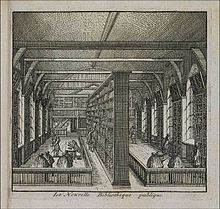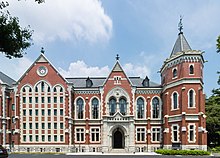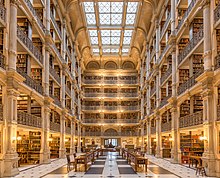Academic library
Academic libraries are a type of library that focuses on education materials. They are usually part of a university or college.
Academic libraries need to choose carefully what items they should have, because it is not practical to try and have unlimited items in the library. Librarians can make this decision based on what students, faculty, and other people at the school need. Some academic libraries have special collections with original papers and rare items. Academic libraries can be very different from each other. They can be very different sizes, have different items, and do different things.

The Harvard University Library is the biggest academic library in the world,[1] but the Danish Royal Library (which is a national library and an academic library) has a larger collection.[2] The University of the South Pacific is another big lacademic library, it has libraries in twelve different countries.[3] The University of California has the largest academic library system in the world, with more than 40.8 million print volumes across 100 libraries on ten campuses.[4]


History
[change | change source]Libraries have been around for a very long time. Two of the oldest libraries we know about are the Library of Alexandria and the Library of Nalanda University, which apparently burned for months because of the sheer number of manuscripts.[5]
United States
[change | change source]

The first colleges in the United States were to train clergy members. These libraries mostly had donated books. In 1766, Yale had about 4,000 books, second only to Harvard.[6] Only faculty members and some students were allowed in these librarys and there was only one librarian.[7] The library's purpose was to protect books, not to let people read them.
In 1849, Yale was open 30 hours a week and the University of Virginia was open nine hours a week, Columbia University four, and Bowdoin College only three.[8] Because students could not use the libraries, they made literary societies and built small collection of usable books, usually more than what the library let them use.[8]
The American Library Association (ALA) was formed in 1876 and libraries changed their purpose to let more people access their materials. This meant they got more money from the universities because people were using them more.[9]
Canada
[change | change source]Academic libraries in Canada are not as old as other counties. The first academic library in Canada opened in 1789 in Windsor, Nova Scotia.[10] A
cademic libraries were very small until the 1950s, when Canadian academic libraries began to grow when people started to think education and research was more important.[10] In the 1960s, academic libraries grew a lot because of universities have more students, having more money, and people starting to admire libraries.[11] The Ontario New Universities Library Project started in the 1960s, and many libraries got extra money from the Canada Council and the Social Sciences and Humanities Research Council, because they wanted to make the library's collections bigger.[10]
After the 60s, library growth in Canada slowed down because they were being given less money.[12] Libraries had started interlibrary lending, and getting more resources, which cost more money.[12] Canadian academic libraries often didn't have supplies and weren't organised well.[13]
Academic libraries in Canada managed to do well because they were helped by other organisations. The Ontario Council of University Libraries (OCUL) was created in 1967 to help Canadian libraries work together better.[14]
The Ontario College and University Library Association (OCULA) is conencted to the Ontario Library Association (OLA) and helps academic librarians with issues about academic libraries.[15]
Europe
[change | change source]Some of the oldest academic libraries in Europe include the Bodleian Library at the University of Oxford, the Library of Trinity College Dublin, and the Vilnius University Library in Lithuania.
European libraries are similar to ones in Norther America. European libraries as less likely to use the Dewey Decimal Classification (DDC) asmany have their own way of organising materials.[16]
Modern academic libraries
[change | change source]
Lot's of 21st century libraries have digital collections. Academic libraries today often let people have access to journals that are behind paywalls, and loan out eb
Academic libraries have transformed in the 21st century to focus less on physical collection development, information access, and digital resources. Today's academic libraries typically provide access to subscription-based online resources, including research databases and ebooks.
Academic libraries usually have space for students to work and study, in groups or by themself.They sometimes have "silent areas" for people who want to study in silence, and a help desk.[17][18] Some academic libraries lend out technology like video cameras, iPads, and calculators. Lot's of academic libraries focus on teaching people information literacy (how to read and understand material well).[19] In many academic libraries, librarians are considered faculty.[20]
Related pages
[change | change source]Notes and references
[change | change source]- ↑ Pezzi, Bryan (2000). Massachusetts. Weigl Publishers. p. 15. ISBN 978-1-930954-35-9.
- ↑ "Årsberetning 2015" (PDF) (in Danish). 2015. Retrieved 2017-08-28.
- ↑ Curzon, Susan; Jennie Quinonez-Skinner (9 September 2009). Academic Libraries. pp. 11–22. doi:10.1081/E-ELIS3-120044525. ISBN 978-0-8493-9712-7. Retrieved 10 September 2013 – via Encyclopedia of Library and Information Sciences.
- ↑ Westbrook, Danielle Watters; Chua, Kristen. "Facts and Figures – UC Libraries". UC Libraries. Archived from the original on 1 December 2022. Retrieved 20 February 2023.
- ↑ "Nalanda—the lost beacon of knowledge". Times of India Travel. Retrieved 2022-11-14.
- ↑ Budd, John M. (1998). The Academic Library: Its Context, Its Purpose, and Its Operation. Englewood, Colorado: Libraries Unlimited. pp. 30–31.
- ↑ McCabe, Gerard; Ruth J. Person (1995). Academic Libraries: Their Rationale and Role in American Higher Education. Westport, Connecticut: Greenwood Press. pp. 1–3.
- ↑ 8.0 8.1 Budd (1998), p. 34
- ↑ McCabe (1995), pp. 1-3.
- ↑ 10.0 10.1 10.2 Beckman, M.; Dahms, M.; Lorne, B. (2010). "Libraries". Archived from the original on 14 September 2012.
- ↑ Downs, R. B. (1967). Resources of Canadian academic and research libraries. Ottawa, ON.: Association of Universities and Colleges of Canada. pp. 9.
- ↑ 12.0 12.1 University research libraries: Report of the consultative group on university research libraries. Ottawa, ON: The Canada Council. 1978. p. 4.
- ↑ University research libraries: Report of the consultative group on university research libraries. Ottawa, ON: The Canada Council. 1978. p. 2.
- ↑ "A History of Collaboration". Ontario Council of University Libraries. 2011. Archived from the original on 2012-08-26. Retrieved 2017-02-17.
- ↑ Ontario Library Association (n.d.). "About OCULA". Archived from the original on 6 December 2011.
{{cite web}}: CS1 maint: year (link) - ↑ "Library Resources Outside the U.S." Brown University Library. 2020. Retrieved 2023-04-28.
- ↑ "Changing Roles of Academic and Research Libraries". Association of College & Research Libraries (ACRL). 2018-05-30. Retrieved 2019-07-12.
- ↑ "Explore 5th Floor USF Libraries Tampa in 3D". Matterport. Retrieved 2023-09-20.
- ↑ Research Planning and Review Committee, ACRL (5 June 2018). "2018 top trends in academic libraries: A review of the trends and issues affecting academic libraries in higher education" (PDF). College & Research Libraries News. 79 (6): 286. doi:10.5860/crln.79.6.286.
- ↑ "Academic Libraries". Education & Careers. American Library Association. 2016-07-21. Retrieved 2019-07-12.
Further reading
[change | change source]- Bazillion, Richard J. & Braun, Connie (1995) Academic Libraries as High-tech Gateways: a guide to design and space decisions. Chicago: American Library Association ISBN 0838906567
- --do.-- --do.-- 2nd ed. --do.-- 2001 ISBN 083890792X
- Jürgen Beyer, « Comparer les bibliothèques universitaires », Arbido newsletter 2012:8
- Ellsworth, Ralph E. (1973) Academic library buildings: a guide to architectural issues and solutions 530 pp. Boulder: Associated University Press
- Giustini, Dean (2011, 3 May) Canadian academic libraries' use of social media, 2011 update [Web log post]. Retrieved from https://web.archive.org/web/20110512080605/http://blogs.ubc.ca/dean/2011/05/canadian-academic-libraries-use-of-social-media-2011-update/
- Hamlin, Arthur T. (1981). The University Library in the United States: Its Origins and Development. Philadelphia: University of Pennsylvania Press. ISBN 9780812277951
- Hunt, C. J. (1993) "Academic library planning in the United Kingdom", in: British Journal of Academic Librarianship; vol. 8 (1993), pp. 3–16
- Shiflett, Orvin Lee (1981). Origins of American Academic Librarianship. Norwood, N.J.: Ablex Pub. Corp. ISBN 9780893910822
- Taylor, Sue, ed. (1995) Building libraries for the information age: based on the proceedings of a symposium on The Future of Higher Educational Libraries at the King's Manor, York 11–12 April 1994. York: Institute of Advanced Architectural Studies, University of York ISBN 0-904761-49-5
- Letzter, Jonathan (2022). The architecture of academic libraries in Israel: Knowledge and prestige. The Journal of Academic Librarianship, Volume 49, Issue 2, March 2023: https://www.sciencedirect.com/science/article/abs/pii/S0099133322001616
